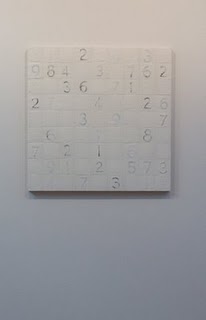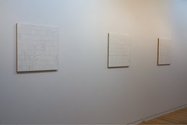John Hurrell – 4 July, 2009
Ruth Watson clearly sees this numbers game as a metaphor for art practice, but she, as a regular player, might be addicted too.
Sudoku is one of those games that requires a strong sense of strategy in figuring out how to get those nine sets of nine numbers to co-operate within the requirements of a grid. In your matrix of 81 squares you have not only vertical and horizontal alignments in which to place each of the nine digits, but you have the nine larger squares that divide up the board. Tricky stuff - a bit like making art (co-ordinating the elements), or the politics of making art (pitching to the constituency of its audience).
Ruth Watson clearly sees this numbers game as a metaphor for art practice, but she, as a regular player, might be addicted too. (Like artmaking?) These highly sensual encaustic paintings allude to her very early graduate show in the CSA in Christchurch in the mid-eighties, which I happened to see and write about. At that time the encaustic technique of applying thin melted wax to plywood panels was highly unusual - and still is. The only other artist I’ve ever heard of using it is Jasper Johns. Another numbers guy.
In our culture the ultimate ‘numbers guy’ is Colin McCahon, with his different counting series encompassing the late fifties to mid-seventies, and superbly written about by Wystan Curnow, Gordon Brown and others. With Watson, the Platform works demonstrate a similar enthusiasm for mental processes. With McCahon you jump around with your eye from number to number, following the sequence as you count (or recite) it. And with earlier board game art works that Watson has made (like Snakes and Ladders), you mentally count squares, move your imaginary counter and recreate the playing process.
With Watson it is more complicated because with this Sudoku project you have a game which is not so much about sequencing as filling in gaps within a series - and mentally testing alternative possibilities. It blends counting with the structural logic of crosswords. (And an earlier series of enlarged Scrabble pieces.) However these works, if they are to be more than sensual treats, need your mental participation and maybe physical too - ie. grabbing pencil and paper and responding to the challenge, grappling with filling the gaps. Few people will do that unless they become obsessed with Sudoku or already are. That is Watson’s risk - of being too obscure to really engage.
Another area of discussion is the relationship between medium and content. Some of the numbers have more overlaid encaustic layers than others, making them fainter - as if being placed earlier only to now fade in the player’s memory. This could allude to the chronological process of filling in the board. The extra layering on some numbers might also indicate lack of confidence in their placement, an attempted erasure.
Despite Sudoku being widely prevalent in newspapers, magazines and websites, there is something extremely introverted about these paintings - something inaccessible and withheld. This is because the sentient processes alluded to remain out of reach, those necessary little cognitive twists and turns that shuffle tested numbers around within such a game’s progression. They lie buried in the cumulative distribution of digits and wax so that the movement of placing rejected or accepted numbers around the board is not fully charted.
Because the nine ‘puzzles’ are nowhere near completion, the procedure is too open to provide a sharpened conceptual focus - to tease the viewer into finishing rows or columns. Their lack of information makes them intimidating - especially to Sudoku novices. Despite being highly attractive objects with their layered, milky, translucent wax, they only allow the reader limited mental participation.
John Hurrell



 Two Rooms presents a program of residencies and projects
Two Rooms presents a program of residencies and projects Advertising in this column
Advertising in this column



This Discussion has 0 comments.
Comment
Participate
Register to Participate.
Sign in
Sign in to an existing account.